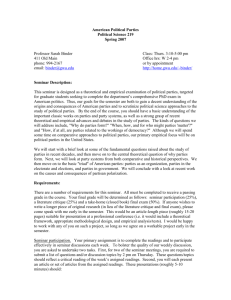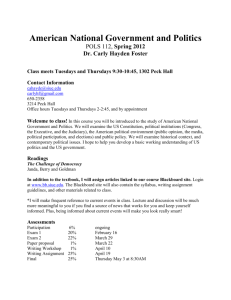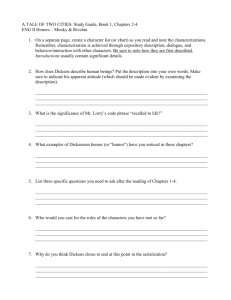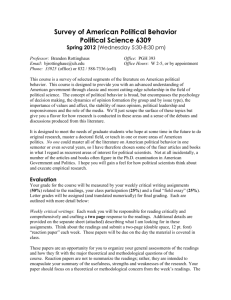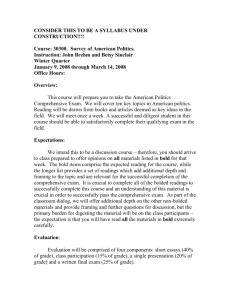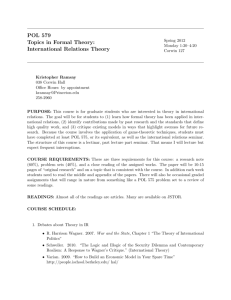Books for American Core Seminar, Druckman(all need desk copies)
advertisement
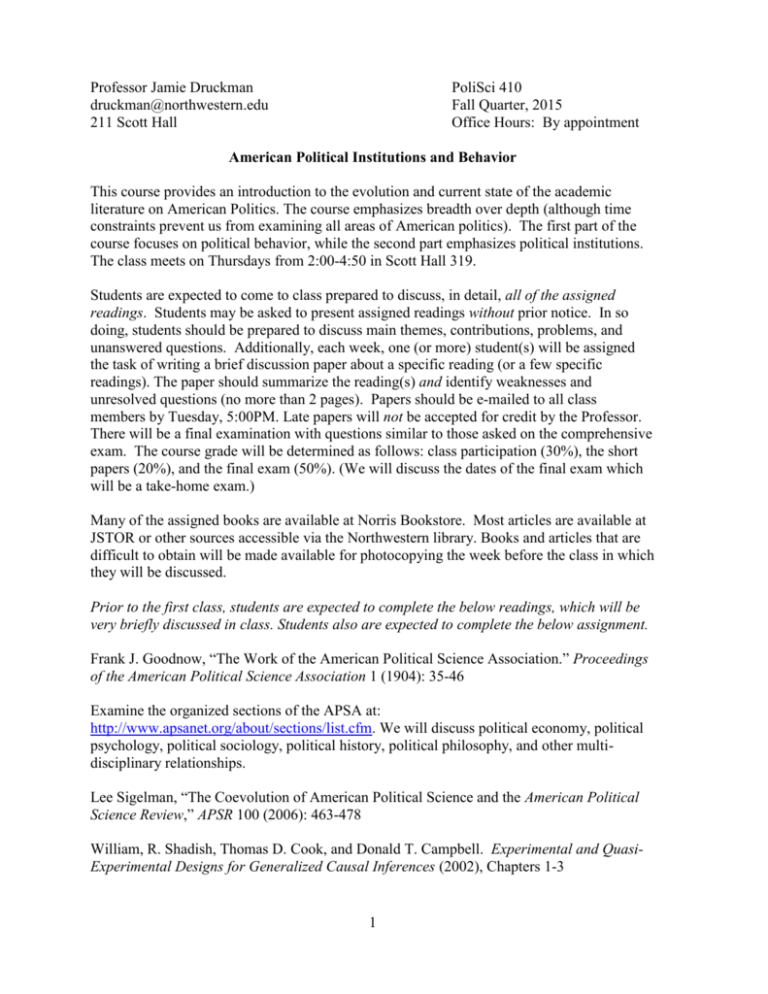
Professor Jamie Druckman druckman@northwestern.edu 211 Scott Hall PoliSci 410 Fall Quarter, 2015 Office Hours: By appointment American Political Institutions and Behavior This course provides an introduction to the evolution and current state of the academic literature on American Politics. The course emphasizes breadth over depth (although time constraints prevent us from examining all areas of American politics). The first part of the course focuses on political behavior, while the second part emphasizes political institutions. The class meets on Thursdays from 2:00-4:50 in Scott Hall 319. Students are expected to come to class prepared to discuss, in detail, all of the assigned readings. Students may be asked to present assigned readings without prior notice. In so doing, students should be prepared to discuss main themes, contributions, problems, and unanswered questions. Additionally, each week, one (or more) student(s) will be assigned the task of writing a brief discussion paper about a specific reading (or a few specific readings). The paper should summarize the reading(s) and identify weaknesses and unresolved questions (no more than 2 pages). Papers should be e-mailed to all class members by Tuesday, 5:00PM. Late papers will not be accepted for credit by the Professor. There will be a final examination with questions similar to those asked on the comprehensive exam. The course grade will be determined as follows: class participation (30%), the short papers (20%), and the final exam (50%). (We will discuss the dates of the final exam which will be a take-home exam.) Many of the assigned books are available at Norris Bookstore. Most articles are available at JSTOR or other sources accessible via the Northwestern library. Books and articles that are difficult to obtain will be made available for photocopying the week before the class in which they will be discussed. Prior to the first class, students are expected to complete the below readings, which will be very briefly discussed in class. Students also are expected to complete the below assignment. Frank J. Goodnow, “The Work of the American Political Science Association.” Proceedings of the American Political Science Association 1 (1904): 35-46 Examine the organized sections of the APSA at: http://www.apsanet.org/about/sections/list.cfm. We will discuss political economy, political psychology, political sociology, political history, political philosophy, and other multidisciplinary relationships. Lee Sigelman, “The Coevolution of American Political Science and the American Political Science Review,” APSR 100 (2006): 463-478 William, R. Shadish, Thomas D. Cook, and Donald T. Campbell. Experimental and QuasiExperimental Designs for Generalized Causal Inferences (2002), Chapters 1-3 1 Paul W. Holland, “Statistics and Causal Inference.” Journal of the American Statistical Association 81 (1986): 945-960 Assignment: Each student should choose one article from the American Political Science Review’s November 2006 issue on the Evolution of Political Science. The student will write a 1 page overview of it. Submit papers to all class participants by September 22, and come ready to very briefly discuss. Class 1, September 24. American Political Institutions and Culture The Declaration of Independence and the U.S. Constitution The Federalist Papers, Numbers 10, 51, 70, and 78 Alexis de Tocqueville, Democracy in America, Part I, Sections 2, 3, and 5; Part II, Sections 3-9 (all from Volume 1) Louis Hartz, The Liberal Tradition in America (1955), Chapter 1 Rogers M. Smith, “Beyond Tocqueville, Myrdal, and Hartz: The Multiple Traditions of America,” APSR 87 (1993): 549-566 Jacqueline Stevens and Rogers M. Smith (reply). “Beyond Tocqueville, Please!” APSR 89 (1995): 987-995 Class 2, October 1. Political Participation Anthony Downs, An Economic Theory of Democracy (1957), Chapter 14 William Riker and Peter Ordeshook, “A Theory of the Calculus of Voting,” APSR (1968): 25-41 Steven J. Rosenstone and John Mark Hansen, Mobilization, Participation, and American Democracy (1993), Chapters 1-2, 8 Henry Brady, Sidney Verba, and Kay L. Schlozman, “Beyond SES: A Resource Model of Political Participation,” APSR 89 (1995): 271-294 Robert Putnum, “Bowling Alone: America’s Declining Social Capital,” Journal of Democracy 6 (1995): 65-78 Alan S. Gerber and Donald P. Green, “The Effects of Personal Canvassing, Telephone Calls, and Direct Mail on Voter Turnout: A Field Experiment,” APSR 94 (2000): 653-664 Michael P. McDonald and Samuel L. Popkin, “The Myth of the Vanishing Voter,” APSR 95 (2001): 963-974 2 Yanna Krupnikov. “When Does Negativity Demobilize? Tracing the Conditional Effect of Negative Campaigning on Voter Turnout,” AJPS 44 (2011): 797-813. Melanie J. Springer. “State Electoral Institutions and Voter Turnout in Presidential Elections, 1920-2000,” State Politics and Policy Quarterly 12 (2012): 252-283. Jan E. Leighley and Jonathan Nagler. Who Votes Now?: Demographics, Issues, Inequality, and Turnout in the United States” (2013). Chapters 6, 7 Class 3, TBA. Public Opinion. Philip E. Converse, “The Nature of Belief Systems in Mass Publics,” In David Apter (ed.), Ideology and Discontent (1964), Chapter 6 (excerpts) Samuel Kernell, “Explaining Presidential Popularity,” APSR 72 (1978): 506-522 Shanto Iyengar and Donald Kinder, News That Matters (1987), Chapters 1-3, 7, 12 John Zaller and Stanley Feldman, “A Simple Theory of Survey Response,” AJPS 36 (1992): 579-616 John L. Sullivan and John E. Transue. “The Psychological Underpinnings of Democracy: A Selective Review on Political Tolerance, Interpersonal Trust, and Social Capital,” Annual Review of Psychology 50 (1999): 625-650 Robert S. Erikson, Michael B. MacKuen, and James A. Stimson, The Macro Polity (2002), Chapter 1 Charles S. Taber and Milton Lodge. “Motivated Skepticism in the Evaluation of Political Beliefs.” AJPS 50 (2006): 755-769 Matthew Levendusky, “Clearer Cues, More Consistent Voters” Political Behavior 32 (2010): 111-131 William G. Jacoby, “Is There a Culture War? Conflicting Value Structures in American Public Opinion.” APSR 108 (2014): 754-771 James N. Druckman and Arthur Lupia, “Preference Change in Competitive Political Environments,” Annual Review of Political Science, Forthcoming Class 4, October 15 Voting Behavior Bernard R. Berelson, Paul F. Lazarsfeld, and William N. McPhee, Voting (1954), Chapters 1, 6-7, 11-12, 14 Anthony Downs, An Economic Theory of Democracy (1957), Chapters 1, 3, 11-13 3 Angus Campbell, Philip Converse, Warren Miller, and Donald Stokes, The American Voter (1960), Chapters 1-4, 6-7, 19-20 Morris Fiorina, Retrospective Voting in American National Elections (1981), Chapters 1, 5, 9, 10 Gary Jacobson, “Strategic Politicians and the Dynamics of House Elections, 1946-1986,” APSR 83 (1989): 773-793 John Ferejohn, “The Spatial Model and Elections,” In Bernard Grofman, ed., Information, Participation, & Choice (1995) Richard R. Lau and David P. Redlawsk, “Advantages and Disadvantages of Cognitive Heuristics in Political Decision Making,” AJPS 45 (2001): 951-971 Stephen Ansolabehere, Jonathan Rodden, and James M. Snyder Jr., “The Strength of Issues: Using Multiple Measures to Gauge Preference Stability, Ideological Constraint, and Issue Voting,” APSR 102 (2008): 215-232 Andrew Healy, and Neil Malhotra. “Retrospective Voting Reconsidered,” Annual Review of Political Science 16 (2013): 285-306 Class 5, October 22. Political Parties “Toward a More Responsible Two-Party System: A Report of the Committee on Political Parties,” APSR 44 (3, supplement) (1950): Forward, 1-14 V.O. Key, Jr., “A Theory of Critical Elections,” JOP 17 (1955): 3-18 Anthony Downs, Economic Theory of Democracy (1957), Chapter 8 Morris Fiorina, “The Decline of Collective Responsibility in American Politics,” Daedalus 109 (1980) Keith T. Poole and Howard Rosenthal, “Spatial Realignment and the Mapping of Issues in American History: The Evidence from Roll Call Voting,” In William H. Riker, ed., Agenda Formation (1993) John Aldrich, Why Parties? The Origin and Transformation of Party Politics in America (1995), Chapters 1-2, 9 Marc J. Hetherington, “Resurgent Mass Partisanship: The Role of Elite Polarization,” APSR 95 (2001): 619-632 Matthew Levendusky, The Partisan Sort (2009), Chapters 2, 3, 7 4 Leonie Huddy, Lilliana Mason, and Lene Aaroe. “Expressive Partisanship: Campaign Involvement, Political Emotion, and Partisan Identity.” APSR 109 (2015): 1-17 Class 6, October 29. Interest Groups David B. Truman, The Governmental Process, 2nd ed. (1971), Introduction and Chapters 2 and 16 E.E. Schattschneider, The Semisovereign People (1960), Chapters 1, 2, 5 Peter Bachrach, and Morton Baratz, “The Two Faces of Power,” APSR (1961): 947-952. Mancur Olson, The Logic of Collective Action (1965), Chapters 1, 2 Theodore Lowi, The End of Liberalism, 2nd ed (1979), Chapters 3, 10 Ken Kollman, “Inviting Friends to Lobby: Interest Groups, Ideological Bias, and Congressional Committees,” AJPS 41 (1997): 519-544 Stephen Ansolabehere, John M. de Figueiredo, John M. Snyder, “Why is There so Little Money in U.S. Politics?”, Journal of Economic Perspectives 17 (2003): 105-130 Dara Z. Strolovitch, Affirmative Advocacy (2007), Chapters 1, 2, 4 Daniel Diermeier, “Private Politics - A Research Agenda,” The Political Economist (2007) 19: 1-2. (http://www.apsanet.org/~polecon/The_Political_Economist.summer07.pdf.). Martin Gilens and Benjamin I. Page. “Testing Theories of American Politics: Elites, Interest Groups, and Average Citizens.” Perspectives on Politics 12 (2014): 564-581. NO CLASS ON NOVEMBER 5TH Class 7, November 12. Congress (and Public Policy) Nelson Polsby, “The Institutionalization of the U.S. House of Representatives,” APSR 62 (1968): 144-168 David R. Mayhew, Congress: The Electoral Connection (1974), Pages 1-77 Richard F. Fenno, Jr. Home Style: House Members in Their Districts (1978), Introduction, Pages 1-33, 214-248 Kenneth A. Shepsle and Barry W. Weingast, “Positive Theories of Congressional Institutions,” LSQ 19 (1994): 149-179 5 Suzanne Mettler and Joe Soss. “The Consequences of Public Policy for Democratic Citizenship: Bridging Policy Studies and Mass Politics,” Perspectives on Politics 2 (2004): 55-73 Alan Wiseman and Craig Volden. “Legislative Effectiveness and Representation,” In, Lawrence C. Dodd, and Bruce I. Oppenheimer. Congress Reconsidered, 10th Ed. Washington DC: CQ Press. 2012 John D. Griffin. “When and Why Minority Legislators Matter.” Annual Review of Political Science 17 (2014): 327-336 Class 8, November 19. The Presidency and the Bureaucracy (part 1) Richard Neustadt, “The Power to Persuade,” In Pietro Nivola and David Rosenbloom, eds., Classic Readings in American Politics, 3rd ed, 370-378 Samuel Kernell, Going Public: New Strategies of Presidential Leadership, 4th ed (2006), Chapters 1, 2, 4 Lyn Ragsdale and John J. Theiss, “The Institutionalization of the American Presidency, 1924-92,” AJPS 41 (1997): 1280-1318 Matthew A. Baum and Samuel Kernell, “Has Cable Ended the Golden Age of Presidential Television?” APSR 93 (1999): 99-114 Daniel Galvin, Presidential Party Building (2010), Chapters 1-2 James N. Druckman and Lawrence R. Jacobs, “Presidential Responsiveness to Public Opinion,” in George C. Edwards III and William G. Howell, eds., The Oxford Handbook of the American Presidency (2009): 160-181 James Q. Wilson, “The Bureaucracy Problem,” In Pietro Nivola and David Rosenbloom, eds., Classic Readings in American Politics, 3rd ed, 405-410 Hugh Heclo, A Government of Strangers: Executive Politics in Washington (1977), Chapter 1 Theodore Lowi, The End of Liberalism, 2nd ed (1979), Chapter 5 Class 9, December 3. Bureaucracy (Party 2) and the Courts Mathew McCubbins and Thomas Schwartz, “Congressional Oversight Overlooked: Police Patrols vs. Fire Alarms,” AJPS 28 (1984): 165-179 Mathew McCubbins, Roger Noll, and Barry Weingast “Administrative Procedures as Instruments of Political Control,” Journal of Law, Economics, and Organization 3 (1987): 243-277 6 Sean Gailmard and John Patty, “Formal Models of Bureaucratic Politics, Annual Review of Political Science (2012): 353-377 Walter F. Murphy, “Marshalling the Court,” In Pietro Nivola and David Rosenbloom, eds., Classic Readings in American Politics, 3rd ed, 445-484 Martin Shapiro, “The Presidency and the Federal Courts,” In Pietro Nivola and David Rosenbloom, eds., Classic Readings in American Politics, 3rd ed, 485-494 Robert G. McCloskey, The American Supreme Court, 2nd ed, (1994), Chapters 1-3, Epilogue Donald R. Songer, Jeffrey A. Segal, and Charles M. Cameron, “The Hierarchy of Justice: Testing a Principal-Agent Model of Supreme Court-Circuit Court Interactions,” AJPS 38 (1994): 673-696 Brandice Canes-Wrone, “Bureaucratic Decisions and the Composition of the Lower Courts,” AJPS 47 (2003): 205-214 Brandon L. Bartels and Christopher D. Johnston. “On the Ideological Foundations of Supreme Court Legitimacy in the American Public.” AJPS 57 (2013): 184-199. Peter K. Enns and Patrick C. Wohlfarth. “The Swing Justice.” JOP 75 (2013): 1089–1107. Class 10, December 10. Open Class to Complete Unfinished Topics. 7
